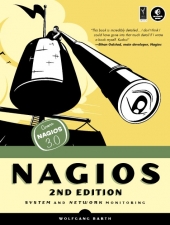Foreword to the Second Edition
Introduction
PART I: From Source Code to a Running Installation
Chapter 1: Installation
Chapter 2: Nagios Configuration
Chapter 3: Startup
PART II: In More Detail...
Chapter 4: Nagios Basics
Chapter 5: Service Checks and How They Are Performed
Chapter 6: Plugins for Network Services
Chapter 7: Testing Local Resources
Chapter 8: Plugins for Special Tasks
Chapter 9: Executing Plugins via SSH
Chapter 10: The Nagios Remote Plugin Executor (NRPE)
Chapter 11: Collecting Information Relevant for Monitoring with SNMP
Chapter 12: The Nagios Notification System
Chapter 13: Passive Tests with the External Command File
Chapter 14: The Nagios Service Check Acceptor (NSCA)
Chapter 15: Distributed Monitoring
PART III: The Web Interface and Other Ways to Visualize Nagios Data
Chapter 16: The Classical Web Interface
Chapter 17: Flexible Web Interface with the NDOUtils
Chapter 18: NagVis
Chapter 19: Graphic Display of Performance Data
PART IV: Special Applications
Chapter 20: Monitoring Windows Servers
Chapter 21: Monitoring Room Temperature and Humidity
Chapter 22: Monitoring SAP Systems
Chapter 23: Processing Events with the EventDB
PART V: Development
Chapter 24: Writing Your Own Plugins
Chapter 25: Determining File and Directory Sizes
Chapter 26: Monitoring Oracle with the Instant Client
Appendix A: An Overview of the Nagios Configuration Parameters
Appendix B: Rapidly Alternating States: Flapping
Appendix C: Event Handlers
Appendix D: Macros
Appendix E: Single Sign-On for the Nagios Web Interface
Appendix F: Tips on Optimizing Performance
Appendix G: The Embedded Perl Interpreter
Appendix H: What's New in Nagios 3.0?
Index
View the detailed Table of Contents (PDF)
View the Index (PDF)

